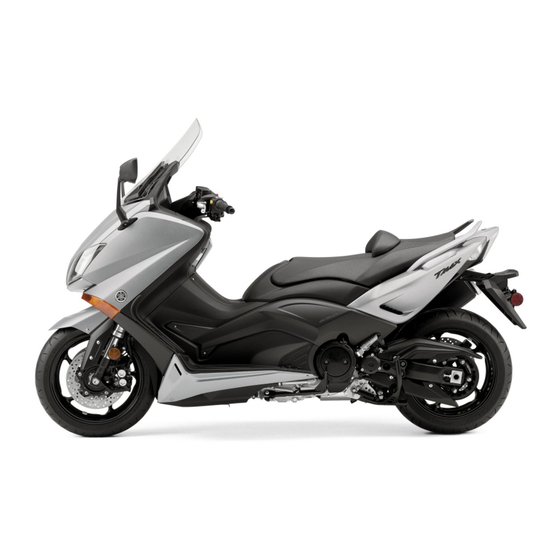
Summarization of Contents
Motorcycle Safety Guidelines
Owner Responsibility and Safe Riding Practices
Defines owner's role and essential safe riding techniques.
Protective Gear and Hazard Avoidance
Recommends protective apparel and identifies hazards like CO poisoning.
Loading, Accessories, and Tire Safety
Guidelines for cargo loading, Yamaha accessories, and tire considerations.
Transporting and Safe Riding Tips
Instructions for transporting the vehicle and additional safe riding advice.
Vehicle Component Identification
Left Side Component Layout
Identifies key components visible from the left side of the scooter.
Right Side Component Layout
Identifies key components visible from the right side of the scooter.
Controls and Instruments Layout
Details the location and function of handlebar controls and dashboard instruments.
Smart Key System Operation
Smart Key System Overview and Safety
Explains the smart key system's function and provides important safety warnings.
Key Operating Range and Handling
Details the system's operating range, potential interference, and key management.
Smart Key Operations and Battery
Covers turning the key on/off, using the mechanical key, and battery replacement.
Vehicle Power, Locking, and Storage
Procedures for powering the vehicle, locking mechanisms, and accessing storage.
Parking Mode and Emergency Procedures
Explains parking mode and emergency operation.
Advanced Vehicle Features
Cruise Control System Guide
Instructions for using the cruise control system, including activation and deactivation.
D-Mode (Drive Mode) System Explained
Details the touring (T) and sports (S) engine performance modes.
Traction Control System (TCS) Function
Explains how the TCS operates and how to manage its settings.
Instruments and Controls Guide
Handlebar Switches and Indicator Lights
Identifies handlebar switches and explains indicator lights on the dashboard.
Dashboard Instruments and Displays
Explains the speedometer, tachometer, and multi-function display functions.
Display Settings and Indicators
Covers drive modes, replacement indicators, and various display settings.
Lever Controls and Vehicle Systems
Details operation of brake levers, ABS, fuel system, and catalytic converter.
Vehicle Components and Systems
Explains windshield, mirrors, suspension, DC jack, sidestand, and ignition system.
Pre-Operation Safety Checks
Pre-Ride Vehicle Inspection Checklist
Comprehensive list of checks before riding for safety and proper operation.
Riding Operation and Techniques
Starting Engine and Basic Riding
Steps for starting the engine and initial riding maneuvers.
Braking and Fuel Efficiency Tips
Proper braking techniques and advice for reducing fuel consumption.
Engine Break-in and Parking
Guidance on engine break-in procedures and safe parking practices.
Periodic Maintenance and Adjustment
Maintenance Overview and Schedules
Importance of regular maintenance, warnings, and tool kit contents.
Component Checks and Replacements
Procedures for checking/replacing spark plugs, filters, brakes, tires, and fuses.
Chassis, Electrical, and Lubrication Tasks
Maintenance for tires, wheels, brakes, steering, battery, and lubrication points.
Troubleshooting and Emergency Procedures
Steps for diagnosing issues, handling engine overheating, and emergency mode.
Scooter Care and Storage
Cleaning and Care Instructions
Guidelines for cleaning matte finishes, general care, and windshield cleaning.
Vehicle Storage Procedures
Steps for short-term and long-term storage to protect the vehicle.
Vehicle Specifications
Dimensions, Weight, and Engine Specs
Technical data on vehicle size, weight, engine, oil, and coolant.
Chassis, Electrical, and Lighting Specs
Specifications for chassis, suspension, electrical system, battery, and lights.
Consumer Information
Identification Numbers and Labels
Location and importance of VIN, engine serial number, and model label.
Vehicle Data Recording
Information about ECU data storage, diagnostic connector, and data usage.















Need help?
Do you have a question about the XP530A and is the answer not in the manual?
Questions and answers